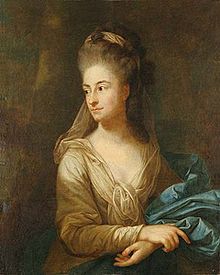Johanna Luise von Werthern

Countess Johanna Luise von Werthern (born February 28, 1752 in Nassau an der Lahn , † March 8, 1811 in Dresden ; born Freiin vom und zum Stein ) was a German noblewoman.
Life
Luise vom und zum Stein was born as one of the nine children of her parents Karl Philipp Reichsfreiherr vom und zum Stein and his wife Henriette Karoline Langwerth von Simmern , widowed Löw von und zu Steinfurth . Her brother, who was five years younger than him, was the well-known future Prussian minister and reformer Freiherr Karl vom und zum Stein . Luise grew up in the Steinschen Castle in the center of Nassau.
In her youth she was adored by Karl August von Hardenberg , who is said to have never confessed his love to her. She was on friendly terms with her drawing teacher in the Steinschen house Georg Melchior Kraus . For a long time, she herself raved about the Grand Court Master of the Elector of Mainz , Baron Friedrich Carl Willibald von Groschlag zu Dieburg . Finally, on July 12, 1773, she married Count Jacob Friedemann von Werthern , 13 years her senior, in Nassau , which her parents and the public saw as a “good match”. Luise followed her husband to his castle in Neunheilingen in Thuringia.
Since he was in the service of the Dresden court , Luise also spent times in the Saxon royal seat. Here she gave birth to her daughter Henriette Caroline Luise on April 9, 1774. In the same year, her husband was appointed to the Spanish court in diplomatic service. Luise followed him to Madrid . Daughter Henriette stayed with his grandmother in Nassau. The second daughter Jacobine Henriette Juliane was born in Madrid on June 27, 1775. However, she died before the age of one and was buried in Madrid. At the end of the 1770s, the von Werthern couple returned from Spain and stayed frequently in Neunheilingen again. Here it also had contacts with the Weimar court . It was during this time that the couple began to tense and alienated, possibly due to the lack of a regular owner, but also due to certain bizarre peculiarities of the husband.
At the same time, Duke Karl August of Weimar became aware of Luise and, although both were married, openly courted her. Together with Goethe he visited Neunheilingen Castle several times. Although Luise was, as is supposed, also favored by him, she nevertheless stuck to their not very happy marriage. Goethe also admired the woman very much, as u. a. is expressed in a letter to Charlotte von Stein . Goethe also incorporated the circumstances and experiences on Neunheilingen into his Wilhelm Meister novels .
In 1783, Count von Werthern became head of the Naumburg-Zeitz monastery government, a position he held until his death. Zeitz was now the main residence of the family, not very far from Eythra , an estate that the Count had acquired in 1772 when he shared an estate with his brother. The expansion of the associated castle and the redesign of the park to the English Garden were actions in which Luise von Werthern was significantly involved. Antique, Gothic and Chinese buildings and monuments emerged, e. B. around 1790 a trianon in the style of Roman temple ruins at the end of the 650 meter long, four-row Eythraer Lindenallee. Similar buildings in Weimar and the Tiefurter Park served as models. In 1795, the wallpaper for the Roman Room of Eythra was ordered, which is still a highlight in the Leipzig Grassi Museum of Applied Art .
After Count von Werthern died in 1806, Luise spent the last years of her life in the royal seat of Dresden. On March 8, 1811, she succumbed to her "many years of lung addiction and emaciation". She was buried next to her husband in the Eythra cemetery.
literature
- Dietrich Wünschmann: The "best of all countesses". In: Eythraer Heimatblätter. No. 4–9 (2001–2002), supplement to the Zwenkauer Nachrichten. Official journal of the city of Zwenkau
- Eythraer Heimatblätter. No. 4 ( Memento of May 4, 2003 in the Internet Archive )
- Eythraer Heimatblätter. No. 5 ( Memento of May 4, 2003 in the Internet Archive )
- Eythraer Heimatblätter. No. 6 ( Memento of May 4, 2003 in the Internet Archive )
- Eythraer Heimatblätter. No. 7 ( Memento of July 1, 2003 in the Internet Archive )
- Eythraer Heimatblätter. No. 8 ( Memento of July 1, 2003 in the Internet Archive )
- Eythraer Heimatblätter. No. 9 ( Memento of May 4, 2003 in the Internet Archive )
- Adolf Bach: Johanna Luise von Werthern, b. from the stone . In: Volk und Scholle, Heimatblätter for both Hessen, Nassau and Frankfurt a. M., Volume 2, 1923/24, pp. 77-82
- Anne Fuchs: Johanna Louise (Jeannette) Countess von Werthern on Neunheiligen, born. vom und zum Stein (1751-1811) , in: Stefanie Freyer, Katrin Horn, Nicole Grochowina (eds.): Frauen-Gestalten Weimar-Jena around 1800. A bio-bibliographical lexicon , Heidelberg 2009, ISBN 978-3-8253- 5656-9 , pp. 378-380.
Individual evidence
- ↑ Goethe's letter to Frau von Stein from March 11, 1781, In: Johann Wolfgang von Goethe: Briefe an Charlotte Stein , Vol. 1 - Chapter 61 ( online )
- ↑ Dietrich Wünschmann in Eythraer Heimatblätter. No. 9, 2002 ( Memento of May 4, 2003 in the Internet Archive )
| personal data | |
|---|---|
| SURNAME | Werthern, Johanna Luise von |
| ALTERNATIVE NAMES | Stein, Johanna Luise from and to (maiden name) |
| BRIEF DESCRIPTION | German nobles |
| DATE OF BIRTH | February 28, 1752 |
| PLACE OF BIRTH | Nassau (Lahn) |
| DATE OF DEATH | March 8, 1811 |
| Place of death | Dresden |